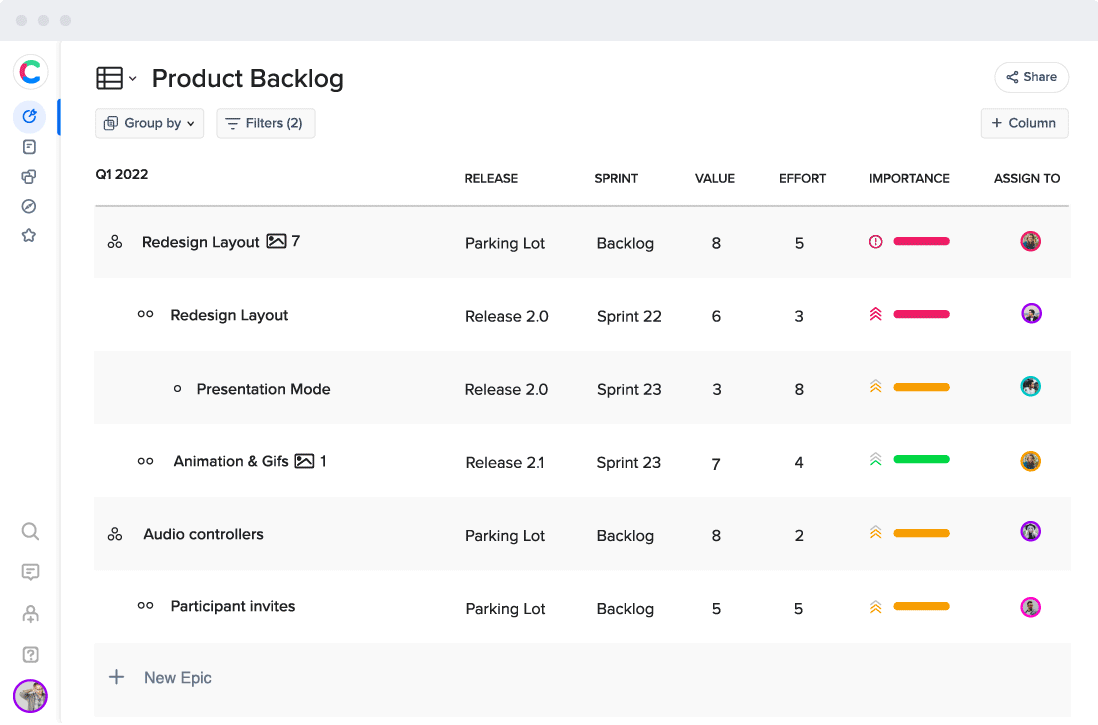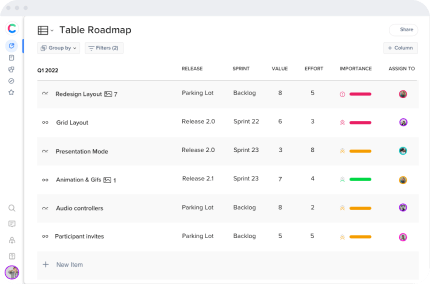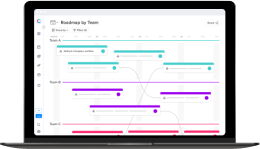Feature advantage and benefits analysis
What Is a Feature, Advantage, and Benefits (FAB) Analysis?
At first glance, these three terms might seem so similar that you could use any of them to describe functionality that will make your products valuable to users. But the feature, advantage, and benefits (FAB) analysis is a useful exercise precisely because these three concepts convey very different information.
In this short glossary entry, we’ll define these terms and explain their key differences. Then we’ll use examples to show you why the FAB analysis is a useful exercise and an important skill for any Product Manager.
We’ll also show you how understanding the differences among these concepts, and knowing which ones will appeal to your different user and buyer personas, can help you develop more compelling marketing messages for your products.
First, let’s define our terms.
Defining the FAB analysis components: features, advantages, and benefits
Feature:
What the product does.
Features are simply the capabilities of a product. They don’t describe the ways the product will enhance the user’s work or life. They explain only the details of the solution and the things it lets the user accomplish.
For a home-gym system, for example, one feature might be a movable flat bench, which lets the user perform bench press exercises inside the equipment and then move the bench aside to perform other exercises in the same space.
Advantage:
Why a feature might matter to the customer.
An advantage helps elaborate on the description of a feature, adding an explanation of how the feature can help users accomplish something valuable to them. You can think of advantages as the bridge between a feature and its benefit.
With our home-gym example, one advantage of the included flat bench is that it allows the user to do bench presses inside the equipment during a workout but keep the gym equipment more compact by moving the bench away or standing it up after the workout.
Benefit:
Why the customer will buy the product.
Benefits describe the bottom-line goal users believe they can accomplish by buying a product.
For the home gym’s flat bench, the benefit might be larger pectoral muscles or a more impressive physique in general. (The bench press, after all, is one of the most important exercises for overall upper-body strength and size.)
The Importance and Purpose of FAB Analysis
You might be thinking that an FAB analysis sounds obvious, something any Product Manager with common sense would know to do intuitively before adding any new functionality to the product roadmap.
But one reason this analysis is such an important part of your overall product strategy is that it forces your team to think through any potential new feature’s contribution to the product’s value from several viewpoints at the same time.
You’ll need to understand the feature’s technical details (what the feature will actually do), what those capabilities will do for the user, and whether or not the positive outcome of those capabilities will persuade customers to buy the product.
This is why conducting an FAB analysis on proposed new functionality should be a part of your product strategy. And if you’d like more guidance on this topic, check out our webinar on creating an effective product strategy.
Another, related reason the FAB analysis is such a valuable exercise is that it helps product teams prioritize when they have more ideas for new functionality than they have the resources, time, or budget to complete.
Note: With the right product management software, your team can choose a pre-built prioritization framework (craft.io has more than a dozen, by the way) and add custom fields – such as advantages and benefits – to help you score each potential feature easily using the same criteria for all competing items on your product backlog.
Also, the right product management software, like craft.io, can include your backlog seamlessly as well – so switching views between your backlog and your prioritization exercises and your roadmaps will always be quick and easy.
To see these capabilities in action, book your free craft.io demo.

An Example of an FAB Analysis
Now let’s see how each component in an FAB analysis – feature, advantage, and benefit – can help a product team think through whether or not a proposed new item will be worth the company’s effort.
For our hypothetical, we’ll use a B2B SaaS company selling a virtual phone solution that lets businesses’ employees make and receive calls (or SMS texts) on their business numbers directly from their computers or through an app on their personal cell phones.
And now imagine someone suggests that the product team add a built-in contact list. Here’s what the FAB analysis might look like.
Feature:
An electronic contact list that users can build and edit in the virtual phone app as well as import pre-existing contact lists into from other data sources.
Notice that the description is value-neutral. All we’re describing is what the proposed functionality will do.
Advantage:
Users can centralize and store all their contacts in their virtual phone app, access the list from both the desktop and mobile versions of the app, and dial a contact with a single click.
Notice that here we’re making some value judgments – describing how this feature could improve some aspect of its users’ workflows.
Benefits:
Next, the product team identifies several benefits of the solution:
- Allows the company’s sales reps to contact more prospects per day.
- Allows the company’s customer service teams to respond more quickly to voicemails.
- Helps the company provide a better caller experience.
Notice here that we’re framing the benefits to the customer – the business buying the solution – as opposed to the end user (the sales reps and customer support agents at the customer company).
Benefits should always be framed as tangible, bottom-line improvements that the product is promising to the buyer – the ultimate reason the customer will choose to buy the product.
If the team is satisfied that both the feature’s advantages and benefits will persuade their respective personas (the end users and the customers’ buyer personas), then the new feature might earn a priority slot on the product roadmap.
Now let’s consider how a feature might fall short during the FAB analysis. Imagine that in addition to the contact list, the product team is also analyzing a sub-feature.
Sub-Feature:
Color-coding for contact list entries by country.
Advantage:
Allows users to more quickly find or recognize contacts by country.
Benefits:
Here the product team thinks through this sub-feature and determines that it doesn’t offer the bottom-line benefits to their business customers that would make it worth the development effort.
For example, they determine that few of the company’s customers have international offices or customers in other countries, meaning the color-coding won’t be relevant often.
This is another reason the FAB analysis is a valuable use of a product team’s time. A proposed piece of functionality might sound like a good idea – and it might even offer a clear advantage to users. But that doesn’t necessarily mean it will contribute enough value to the customer’s bottom line – or persuade enough new customers to buy the product – to be worth the commitment of the company’s finite resources and budget to build and market it.
And that’s why these FAB analysis exercises also play an important role in effective product management capacity planning.
How FAB Analysis Helps Marketing & Sales Messaging
One more reason adding an FAB analysis to your product team’s process is that it can help you create more compelling marketing and sales messages for your product’s various personas.
A common reason these messages fall short is that the company emphasizes a product’ features – or even its advantages – and not the bottom-line, big-picture benefits that will actually move the buyer to act.
So, in our hypothetical above, the product and marketing teams could miss the mark in a couple of different ways with their messaging about the new contact list.
Don’t sell the features:
If the message of the new feature is, “Editable, importable new contact list for your cloud phone system,” that won’t likely resonate with either the end-user or the executive at the customer company with decision-making power to buy the phone system.
That feature description, after all, doesn’t explain why anybody would care about editing or importing a contact list.
Don’t sell the advantages, either (at least not exclusively):
When it comes to crafting marketing messages for a product, this is a more understandable (and tempting) misstep than just describing product features – because the advantages of a product can be impressive. And with a B2B product, they might actually resonate with the end-user persona.
The problem is that advantages alone don’t often move people to buy a product, because they’re too specific and tactical. And in the case of a B2B product in particular, you’re actually selling the decision maker – who wants to hear bottom-line benefits to the business, not how the solution is going to help employees improve some aspect of their workflows.
Will the company’s CEO or head of sales and customer service like the idea of an editable contact list in the company’s phone app? Probably. But will that be enough to move that exec to buy? Probably not.
Sell the benefits!
For our cloud phone solution, our hypothetical team is speaking to executive decision-makers. The only marketing messages likely to break through the noise will be those that highlight tangible, significant benefits to the business. That means describing your phone app’s contact list in terms of its ability to help the company:
- Supercharge your sales team’s close rates by connecting them with more prospects each day.
- Improve your customer-satisfaction rating by empowering your support agents to respond more quickly to customer calls.






